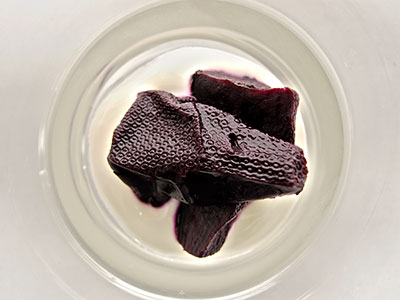August 26, 2013
Amuse-Bouche

betteraves demi-secs
(half-dried beets)
Somewhere deep in the recesses of my mind is a memory of eating strained beets at a very, very young age. Why strained beets? Why not pureed beets? Why beets?
Maybe they were called strained beets because in the old days, one of the methods used to puree foods was to force them through a strainer or a sieve. Both the 1898 Au Bon Marché and the 1895 Montgomery Ward & Co. catalogs show strainers and sieves. They also show a handheld device for pureeing fruits and vegetables that today we call a potato ricer. The label for the device in the Montgomery Ward catalog reads “fruit and vegetable press and strainer.” The French label reads “presse-purée à charnières.” Cooked beets could have been pureed in one of these. The food mill, another suitable tool, doesn’t seem to exist yet, but the hand grinder does. So I wonder, how the manufacturers were processing the beets in the middle of the 20th century when I may have consumed them.
Packaged baby food originates in the 1930s, and I was not a victim of it until about 1948 or 1949. There’s this whiff of strained beets somewhere in my baby-food memory. I have a slightly more solid memory of Pablum or some other cooked cereal, but what I remember there is the box. There’s no memory of my silver-plated baby spoon shoveling the cereal into my mouth. Checking today, it appears that baby food producers no longer sell strained beets.
Whatever my actual memory is, I must have been traumatized by those beets. It wasn’t until 40 years later that I started eating beets, and then it was only pickled beets at salad bars. It wasn’t until I learned how to roast them that I developed a true fondness for them.
So when I ran across a blog posting titled The Tastiest Beet Ever on the Ideas in Food website, my curiosity was stoked. The posting read in part:
The beets are steamed over a bed of aromatics (orange slices, rosemary, savory and grains of paradise) until they are cake tester tender. We then remove the skin and put the warm beets into the dehydrator for 12ish hours. The beets slowly dry and their flavors concentrate. When the beets are shriveled and tender we put them into the refrigerator for several hours to moisten back up. The end result is a tender, chewy beet full of flavor with a chewy caramel meets fudge like texture. The aromatics from the steamer blend with the flavors of the beet and the end result is the tastiest beet we have ever eaten.
I thought it worth a try, so I placed a copy of the instructions in my “Recipes to Try” folder. A few months later, I ran across a bunch of amuse-bouche-size beets in the market and thought back to the recipe.
As is my practice, I decided to simplify the instructions slightly. I rinsed the beets and wrapped each in a piece of foil. The foil wrapped beets were cooked in a 190 °C (375 °F) oven until the tender. When cool, I slipped off their skins and placed them in the dehydrator. After a few hours the beets had a new, dry skin so I decided not to go the full 12 hours that the original recipe called for. I tasted one of the beets and liked the more intense beet flavor. To store them, I vacuum-packed the beets and set their bags in the refrigerator. By the next day, I could see that the dry skin was now soft and hydrated again.
When the vacuum bag was opened, the beet had adopted an interesting new shape from the packaging. (The surface texture in the picture is from the inside surface of the vacuum bag that I used.)
To serve the beets, each was cut in half and set on a dollop of fromage blanc lightened with heavy cream. Very simple.
© 2013 Peter Hertzmann. All rights reserved.
